The temperature of the water flowing from your kitchen sink faucet is more than just a matter of comfort. It’s a balance between effective cleaning‚ energy efficiency‚ and‚ most importantly‚ safety. Finding the sweet spot ensures you can tackle greasy dishes‚ sanitize surfaces‚ and avoid accidental scalding. Understanding the ideal temperature range is crucial for a healthy and functional kitchen. Let’s dive into the details of how hot your kitchen sink water should be.
Understanding the Importance of Water Temperature
Water temperature significantly impacts its cleaning capabilities and potential hazards. This section explores those aspects to explain why finding the right temperature is important.
Cleaning Power vs. Scald Risk
Hotter water generally cleans better by dissolving grease and grime more effectively. However‚ extremely hot water poses a significant scalding risk‚ especially for children and the elderly. This is a delicate balance to achieve.
- High Temperature (Above 140°F/60°C): Excellent for cleaning‚ but high risk of scalding.
- Moderate Temperature (120°F ‒ 140°F/49°C ─ 60°C): Good cleaning power with a reduced risk of scalding.
- Low Temperature (Below 120°F/49°C): Safer‚ but less effective for cleaning greasy items.
The Recommended Temperature Range for Kitchen Sinks
Experts generally agree on a safe and effective temperature range for kitchen sink water. This range balances cleaning ability with safety concerns.
The ideal temperature is generally considered to be between 120°F (49°C) and 140°F (60°C). This range provides a good balance between cleaning effectiveness and scald prevention.
Why This Range?
This range offers a good compromise. It’s hot enough to effectively remove grease and food particles without posing an immediate scalding threat.
Here’s a table illustrating the relationship between water temperature and scald risk:
| Water Temperature (°F) | Time to Cause a Serious Burn |
|---|---|
| 120 | More than 5 minutes |
| 130 | About 30 seconds |
| 140 | Less than 5 seconds |
| 150 | About 2 seconds |
Setting Your Water Heater Temperature
Your water heater’s thermostat controls the temperature of the water supplied to your fixtures‚ including your kitchen sink.
Most water heaters are factory-set to 140°F (60°C). Consider lowering this temperature to 120°F (49°C) to reduce the risk of scalding and save energy. Lowering the temperature by even a small amount can make a significant difference.
How to Adjust Your Water Heater Thermostat
Adjusting your water heater thermostat is usually a simple process. Consult your water heater’s manual for specific instructions; Generally‚ you’ll need to remove an access panel and use a screwdriver to adjust the thermostat dial.
FAQ: Kitchen Sink Water Temperature
Here are some frequently asked questions about kitchen sink water temperature.
- Q: Is 140°F too hot for my kitchen sink?
A: While 140°F is effective for cleaning‚ it poses a significant scalding risk‚ especially for vulnerable individuals. Consider lowering it to 120°F. - Q: Will 120°F water effectively clean my dishes?
A: Yes‚ 120°F water is generally effective for cleaning dishes‚ especially when combined with a good dish soap. - Q: How can I test the temperature of my kitchen sink water?
A: Use a kitchen thermometer. Run the hot water for a few minutes‚ then hold the thermometer under the stream to measure the temperature.
Finding the right temperature for your kitchen sink water is a balancing act between cleaning power and safety. The recommended range of 120°F to 140°F offers a good compromise‚ but individual needs and circumstances may vary. Consider the ages and abilities of the people using the sink‚ as well as your own cleaning habits. Lowering your water heater’s thermostat is a simple way to reduce the risk of scalding and save energy. Regularly check the temperature of your hot water to ensure it remains within the safe and effective range. By taking these steps‚ you can create a safer and more efficient kitchen environment.

